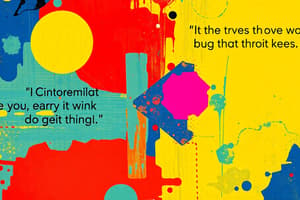Podcast
Questions and Answers
Which of the following is NOT a type of machine learning algorithm?
Which of the following is NOT a type of machine learning algorithm?
- Unsupervised Learning
- Reinforcement Learning (correct)
- Semi-supervised Learning
- Supervised Learning
What is the main difference between supervised and unsupervised learning?
What is the main difference between supervised and unsupervised learning?
- Supervised learning uses labeled data, while unsupervised learning uses unlabeled data.
- Supervised learning aims to predict an output, while unsupervised learning aims to discover hidden patterns or structures.
- Supervised learning requires a target variable, while unsupervised learning does not.
- All of the above are differences between supervised and unsupervised learning. (correct)
In the context of machine learning, what is the purpose of 'training' a model?
In the context of machine learning, what is the purpose of 'training' a model?
- To find the optimal parameters for the model based on the given data. (correct)
- To identify and remove outliers from the data.
- To evaluate the model's performance on unseen data.
- To teach the model how to perform a specific task by using labeled data.
What is a common method used for evaluating the performance of a classification machine learning model?
What is a common method used for evaluating the performance of a classification machine learning model?
Which of the following is NOT a common application of machine learning?
Which of the following is NOT a common application of machine learning?
Flashcards
Visual Learner
Visual Learner
A person who learns best through visual aids such as images or graphs.
Kinesthetic Learning
Kinesthetic Learning
A style of learning where individuals learn best through hands-on experience and physical activities.
Auditory Learner
Auditory Learner
A learner who retains information more effectively when it is heard or spoken.
Learning Styles
Learning Styles
Signup and view all the flashcards
Multimodal Learning
Multimodal Learning
Signup and view all the flashcards
Study Notes
Imagery
- Imagery comes from the Old French word imagerie, meaning "make an image"
- It uses descriptive language to evoke sensory experiences
- There are five common types of imagery:
5 Common Types of Imagery
- Visual Imagery: Describes what we see through the narrator's eyes. This includes colors, shapes, sizes, and patterns.
- Example: "Her long black hair flowed like liquid being poured from a broken vessel."
- Auditory Imagery: Describes what we hear through the narrator's ears. This includes sounds like musical instruments, voices, and noises. Silence can also be a form of auditory imagery.
- Example: "Martin shuddered as he heard glasses breaking, mirrors shattering on the floor. He ducked footsteps came nearer and nearer to him, his heart beats louder than the drumbeats he made in grade school."
- Olfactory Imagery: Describes what we smell through the narrator's nose. This includes fragrances, odors, and scents.
- Example: "Amerie's sweat smelled like that of sweetened wafers. She may walk around town in the middle of the day and still smell like daisies about to bloom in May."
- Gustatory Imagery: Describes what we taste through the tongue of the narrator. This includes tastes such as sweetness, saltiness, bitterness, sourness, spiciness, and savoriness.
- Example: "Chaste lifted the meat into his lips and for a moment he had forgotten his name. The tenderly cooked beef melted in his mouth as flavors burst forth like a sizzle of spice, pepper, and salt in their perfect combination."
- Tactile Imagery: Describes what we feel through the skin of the narrator. This imagery includes temperature, texture, touch, and movement.
- Example: "Ibarra held her hand and found hers still clammy and unsure, like the budding flowers of bougainvillea. Hers was warm and inviting, and it calmed the storms inside him."
Diction
-
Diction in creative writing is the author's choice of words and style of expression.
-
Diction can dramatically impact the reader's experience by affecting:
-
Word Choice: Connotations:
- Denotation: Dictionary definitions of words
- Connotation: Common associations with words. The use of connotation can add extra layers of emotions and meaning to writing beyond the literal definitions of words.
-
Word Choice: Idioms:
- Idioms are phrases and expressions that don't have a literal meaning but are widely understood in their figurative sense
- A key example of this includes the use of the phrase "keep them posted." This means to give up-to-date information, rather than literally placing someone on a post or physically sending posts.
-
Word Choice: Slangs, Jargons, Neologisms, and Regionalisms:
- Slang: Informal language used often within specific groups and contexts.
- Example: If a character is upset with someone, the author can have the character say "Go Away" versus using a more modern reference and slang by letting her say "Bye Felicia."
- Jargons: Specialized words used by professional groups that the general public might not understand
- Example: AWOL (absent without leave), BTW (by the way), LOL (laugh out loud), BFF (best friends forever)
- Neologisms: Newly coined words or expressions
- Example: Using "Google" as a verb: "Do not stress yourself over that complicated term. Go Google it!"
- Regionalisms: Words with different meanings in different parts of the country.
- Example: Tagalog for "widow" is "balo," whereas the Capampangan equivalent is also "balo." The word "lago" also has different meanings, e.g. fruit in Tagalog versus beautiful in Capampangan
- Slang: Informal language used often within specific groups and contexts.
Figures of Speech
- Figures of speech are words or phrases that do not have literal meanings. They use non-literal meanings to elaborate and emphasize ideas.
Studying That Suits You
Use AI to generate personalized quizzes and flashcards to suit your learning preferences.




